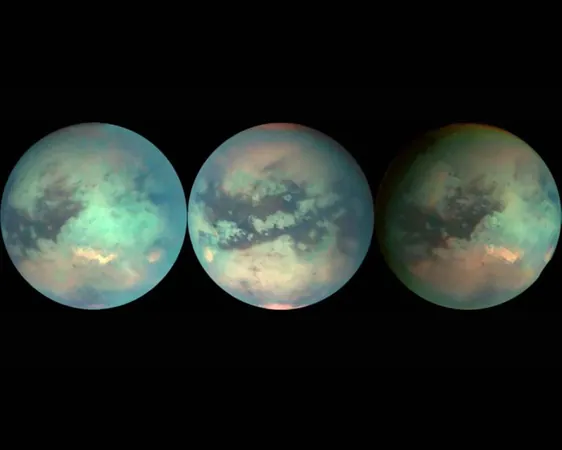
Titan's Methane Weather: Earth-like Yet Alien!
2025-05-21
Author: Wei
Titan: A Mysterious, Methane-Rich World
Saturn's moon Titan is more than just a fuzzy, yellow orb drifting through space; it’s a treasure trove of secrets hidden beneath thick clouds. This intriguing moon boasts a weather system with surprising similarities to Earth – complete with clouds and rain – but here’s the twist: it runs entirely on methane.
New Discoveries Unveiled by Cutting-Edge Telescopes
Utilizing the powerful James Webb Space Telescope alongside the Keck II Telescope, scientists have uncovered thrilling evidence of methane clouds swirling in Titan's northern hemisphere. These latest findings reveal the presence of unique carbon-based molecules high in the atmosphere, providing invaluable insight into Titan’s complex atmospheric chemistry.
Exploring Titan's Summer Skies
NASA's Goddard Space Flight Center, in collaboration with the W.M. Keck Observatory, closely monitored Titan in late 2022 and mid-2023. Their observations revealed the formation of methane clouds in the moon's northern hemisphere just in time for summer. This region hosts the majority of Titan's lakes and seas.
Much like water on Earth, methane here evaporates, ascends, condenses into clouds, and can precipitate as rain. However, Titan's chilly surface temperature freezes water solid – the rain is a frosty, oily drizzle landing on rock-hard water ice.
Tracking the Clouds: A Scientific Breakthrough
The new imagery captured moving clouds, indicating that convection – the rise of warm gases – is taking place in Titan's atmosphere. Previously observed only in the southern hemisphere, this activity sheds light on Titan's dynamic weather patterns. The massive lakes and seas of the northern regions are believed to be key contributors, with methane evaporating from these bodies of liquid.
Unraveling Secrets of Life's Building Blocks
Titan continues to enthrall researchers with its rich tapestry of carbon-based molecules, crucial for the emergence of life. Understanding how these compounds form on Titan can illuminate the origins of life on our own planet.
Methane (CH₄) serves as the foundation for much of this chemistry. When interacting with sunlight or charged particles, methane breaks apart, rearranging into more complex compounds like ethane (C₂H₆).
A New Milestone: Observing Chemical Reactions in Real-Time
Among the standout discoveries from the Webb observations was the detection of the highly reactive methyl radical (CH₃). This transient species forms during the breakdown of methane, bridging the gap between initial reactants and final products.
As co-author Stefanie Milam notes, this breakthrough allows scientists to observe chemical reactions as they unfold, rather than just inspecting the end results.
Titan’s Future: A Methane-Dependent World?
The chemistry of Titan may also reveal clues about its long-term future. As methane breaks down, some hydrogen escapes into space. The fate of Titan hangs in the balance – unless methane is continuously replenished from within its crust or deeper layers, it risks becoming a barren, airless landscape.
Preparing for the Next Frontier: The Dragonfly Mission
While these telescope discoveries offer fantastic insights from afar, NASA is gearing up for an exciting endeavor. The Dragonfly mission, set to land on Titan in 2034, will deploy a flying drone to explore the surface. This close-up examination aims to collect samples and directly measure Titan's unique chemistry.
Heidi Hammel from the Association of Universities for Research in Astronomy emphasizes the importance of integrating data from various sources, including the Webb and Hubble space telescopes, to ensure a cohesive study of Titan's mysteries.
A Journey of Discovery: Uncovering Titan's Secrets
As researchers turn their attention to each methane cloud, they are uncovering the profound secrets of Titan—a world that, while distant, continues to connect us back to the origins and chemistry of life.
Stay tuned for more thrilling updates as we unravel the enigma of this extraordinary moon!




 Brasil (PT)
Brasil (PT)
 Canada (EN)
Canada (EN)
 Chile (ES)
Chile (ES)
 Česko (CS)
Česko (CS)
 대한민국 (KO)
대한민국 (KO)
 España (ES)
España (ES)
 France (FR)
France (FR)
 Hong Kong (EN)
Hong Kong (EN)
 Italia (IT)
Italia (IT)
 日本 (JA)
日本 (JA)
 Magyarország (HU)
Magyarország (HU)
 Norge (NO)
Norge (NO)
 Polska (PL)
Polska (PL)
 Schweiz (DE)
Schweiz (DE)
 Singapore (EN)
Singapore (EN)
 Sverige (SV)
Sverige (SV)
 Suomi (FI)
Suomi (FI)
 Türkiye (TR)
Türkiye (TR)
 الإمارات العربية المتحدة (AR)
الإمارات العربية المتحدة (AR)